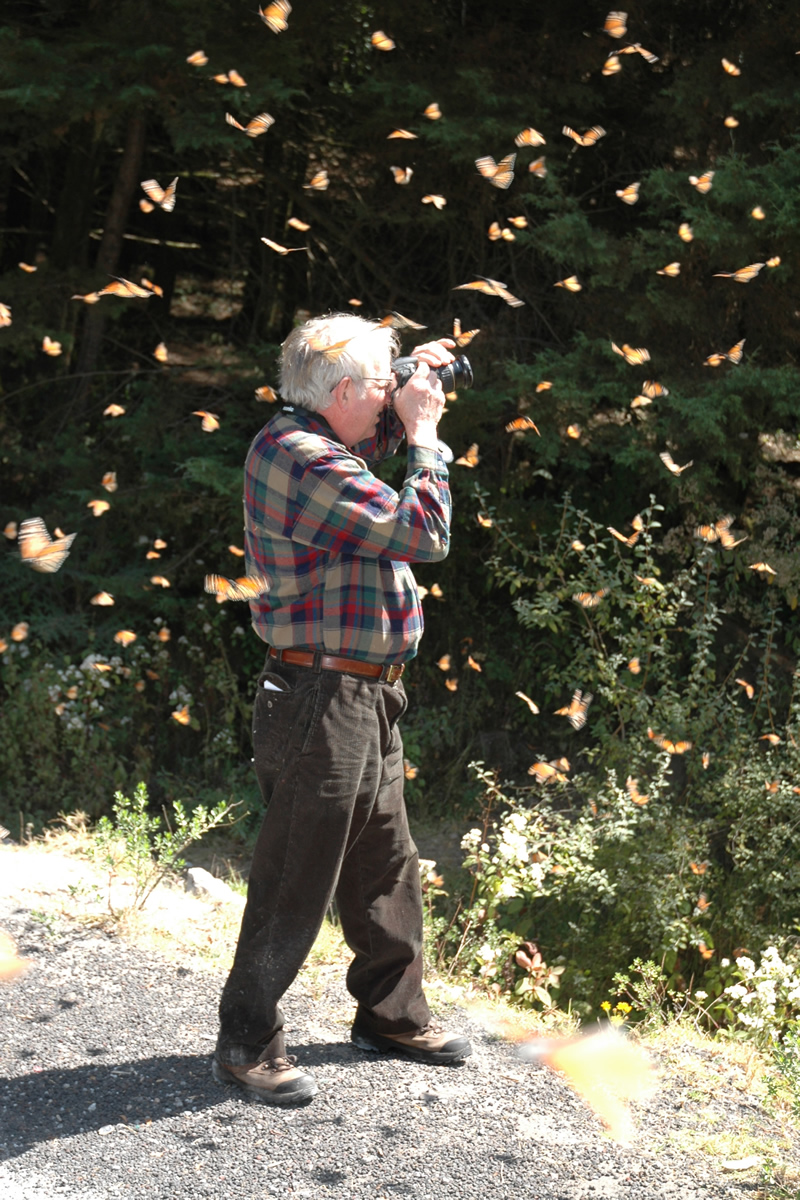Two Weeks With the Butterflies in Mexico
Dr. Lincoln Brower
March 6-17, 2006
|
20
March 2006 |
||
|
Ivan Limon of the University of Mexico |
||
Our aim is to find out what microclimate in the Oyamel forest that the butterflies really like. We have installed about 250 small digital thermometers called "Thermochron I-Buttons" in the Chincua, Pelon and Herrada colony areas. Each I-button is about as big as a stack of 6 dimes, and records the temperature automatically once each hour for 80 days. |
||
Our colleague from NASA, Dan Slayback, has mapped out all the individual tree positions where we have installed these along literally hundreds of meters of paths through the forest. Imagine trying to find each I-Button on a 4 inch long black post attached to the bark of Oyamel trees. We are able to do this using a compass, a laser rangefinder and a GPS global positioning unit. Keeping careful notes is essential! |
||
| In
addition to this project, Cara and I are trying to find out how
important nectaring at flowers is just before the monarchs leave
the colonies to head north at the end of March. Earlier work done
in the middle of the wintering season (January February)
proved that the flowers are not producing enough nectar for the
butterflies. |
||
|
However, as we found on this expedition, by the middle of March, the monarchs are able to obtain substantial nectar. To determine this was a bit grisly, because we had to operate on the monarchs and determine how much nectar was in each crop. Many crops were full, but some had only air in them because the flowers can be so stressed by the severe dry season that they can not produce significant quantities of nectar. The butterflies then suck in air that fills their crops like tiny balloons. We visited the Sierra Chincua colony on Friday 10 March 2006 and found that it had moved down to lower altitude in a beautiful valley known as the Arroyo Honda. Huge clusters of monarchs had reformed on the trees here, presumably because the headwaters of these stream dry out as the season progresses and it is much more moist lower down in the valley. Several years ago, Bill Calvert and I found that the colonies typically move down their arroyos slowly in February and March, and then roll out of the canyon mouth towards the end of March. We wanted to collect some of these late spring monarchs and so returned on Tuesday to the exact spot where they had been. Incredibly, virtually every single monarch was gone! They had left over the weekend, probably on Saturday morning. Now we were really worried, because we thought that all the colonies had broken up and headed north! However, we went the next day to the Cerro Pelon colony...which on this separate mountain was gradually moving down the Ojo de Agua canyon. Much to our relief, we found that many clusters, though thinned out from their earlier high winter densities, were still present. The colony was spread out over a larger area and the monarchs seemed agitated and on the threshold of leaving. Standing quietly in the forest, we would hear an occasional whispering crescendo......and learned quickly that what was happening was that one or several clusters of monarchs suddenly "explode" with butterflies cascading out into the air like a waterfall flowing sideways!! We
believe that these explosions are one of the ways in which the spring
remigration begins....once the clusters break and the individuals
begin flying in the now much warmer weather, many clusters probably
break up in rapid succession, with a building tide of monarchs moving
down hill, out of the valley, and thence northward. This explosion
behavior is absolutely stunning to witness, and if one is lucky,
it is possible to catch the cascading monarchs in a still photo,
or even better, with a video camera. Sincerely
yours, |
||
Monarchs cascading out into the air like a waterfall flowing sideways! |
||
 |
||
Cascading butterflies, as seen from underneath. |
||
|
||
|
||
Reference:
Burgess, E. (1880) Contributions to the anatomy of the milk-weed butterfly
Danaus archippus (Fabr.). Memoirs of the Boston Society of Natural History
(Fiftieth Year Anniversary), 50, 1-16, with 2 plates.











